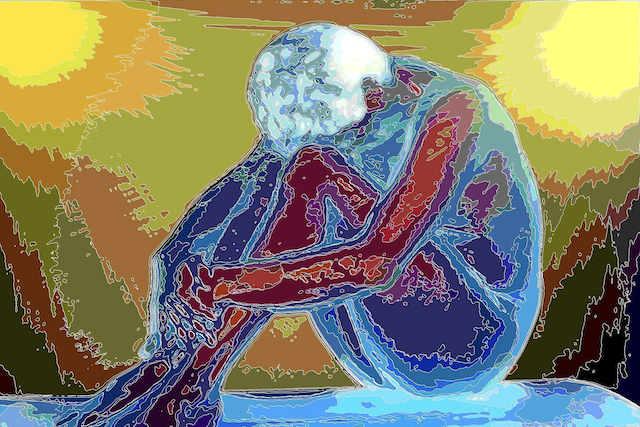The Vastness of a Robe
Falling into bits and pieces, the robe — like everything else — becomes the universe. A teaching by Tenshin Reb Anderson. The post The Vastness of a Robe appeared first on Lions Roar.

Falling into bits and pieces, the robe — like everything else — becomes the universe. A teaching by Tenshin Reb Anderson.
After I was ordained as a priest by Suzuki Roshi in 1970, I asked his wife to order a new linen robe (okesa) for me. Originally, the robe was black. Later, after completing the formal ceremonies of dharma transmission, I was given brown robes. I had the idea to bleach that linen robe, and it came out a lovely, uneven, almost mangy dull brown color. However, I didn’t do a good job with the bleaching, and the fabric was weakened. It gradually started to fall apart in various ways. Even now, it continues falling apart.
Since then, I and many other dharma students have made efforts to care for this fragile robe. A kind person skillfully sewed a new backing on it, which holds the robe together. The front needs ongoing repair. When people see this delicate old robe, they often say that it’s beautiful. What they’re seeing is a motley robe that is falling apart, and in this falling-apart robe they see beauty. Part of its beauty is in the variety of the stitches in which can be seen the kindness of many people.
The robe is in an open-ended process of deterioration and renewal. This robe is not permanent and it is not annihilated. It’s a superficial, perceptible appearance of our profound, imperceptible, original nature.
The robe is in an open-ended process of deterioration and renewal. This robe is not permanent and it is not annihilated. It’s a superficial, perceptible appearance of our profound, imperceptible, original nature.
When I wear this robe, people have an opportunity to open their eyes and hearts to the teaching that all compounded things fall apart: the robe and me. If we can endure this awesome falling apart, we can experience its beauty. However, if we can’t tolerate things falling apart, we close the door on reality, because compounded things are falling apart. They’re falling into bits and pieces of the entire universe.
The way the universe is falling apart and becoming us is our original nature. This is the reality of our life and death. If we are present and endure the terror of this process of falling apart and becoming, we can witness the beauty of life and death. If we can tolerate the feeling of trembling and awe in the face of reality, this process will come to us as beauty.
All day long, everything is turning into infinite parts. All day long, infinite parts are turning into everything. This process is our true nature. It offers us an opportunity to live in accord with the terrifying beauty of wreckage and renewal. In our original nature, there’s no beginning or end. Nothing is completely intact in and of itself. We and all compounded things are subject to wreckage and ruin.
It’s in the midst of our fragility that truth comes to us as beauty. Rainer Maria Rilke put it this way in Duino Elegies:
For beauty is nothing but the beginning of terror
which we are barely able to endure, and it amazes us so,
because it serenely disdains to destroy us.
Every angel is terrible.
Opening to and enduring the awesome impermanence of things is simultaneously opening to their beauty and truth. Ironically, we might say something is beautiful to protect ourselves from its actual beauty, which is terrifying. Doing this, we close the door on the unmanageable and inconvenient reality of our life. Once, Suzuki Roshi surprised me by saying that to call something beautiful is a sin. Calling things beautiful might be a way to minimize them in an attempt to make them manageable by trying to put them into a box called beauty. We could also use the word “cute” for similar purposes. It could be that someone or something we comfortably call “cute” suddenly becomes much more than cute. At that moment the door of mystery might open, and we might feel terror.
I remember Suzuki Roshi saying that our sitting meditation is a great tenderizer. In our sitting, we become tender, flexible, and curious like children so that we have the opportunity for initiation into the vastness of reality. Since childhood, we’ve been learning techniques to hold the vastness of reality at bay, but now in our sitting, we have the opportunity to let go of all techniques. In this way, we learn to be soft, upright, and honest like children. Children and adults do sometimes need techniques in order to cope and feel safe in the face of impermanence. We may need to temporarily turn away from what scares us.
A few years ago, my seventeen-year-old grandson died suddenly in a tragic accident. Someone asked me how I was doing. I replied, “I’m full of life and death.” Our family grieved the loss of this beautiful boy and simultaneously faced the beginning of a terror we could barely tolerate. When he was alive, we weren’t so aware of the terrible aspect of his beauty. The door of an unbearable beauty was opened by his death. In our relationships with those we love, there’s no way to hold on to self and other. Attempting to hold on walls off real love. If we face the terror of losing our grip on these relationships, the wall of separation starts to crack. When we open to that crack and compassionately meet how we feel, the light of beauty and truth emerges. This truth is not our idea of beauty, because our idea of beauty just cracked.
The full experience of beauty and truth includes feeling and accepting our human vulnerability. But experiencing our vulnerability may be frightening. We may feel that the universe is going to overwhelm us and gobble us up. The universe consumes us. That is half of reality. The other half is that we consume the universe. The universe is vulnerable to us, too. This reciprocal vulnerability is our true nature. It is awesome. In the beginning of that awe, beauty is glistening. We also have the opportunity to train by taking care of things so that they show us the truth of our mutual vulnerability. The Japanese poet Saigyo Hoshi wrote:
This leaky, tumbledown
grass hut left an opening for the moon,
and I gaze at it
all the while it was mirrored
in a teardrop fallen on my sleeve.
There are training methods, like our sitting practice, which enable us to tolerate being a leaky, tumbledown grass hut allowing the light of the moon to penetrate our wreckage. We also have the opportunity to train by taking care of things so that they show us the truth of our mutual vulnerability. Training helps us be present with this potentially frightening vulnerability. Training is not to “get” beauty. Training means to become able to tolerate the terror of vulnerability and thus open to the beauty of the moon. Looking at the moon may be exquisitely painful as we accept our mutual dependence and impermanence. The moon simply happens to be beautiful if we accept and realize that we—like Saigyo’s grass hut or my dharma robe or the very moon itself—are always on the verge of breaking, of changing without being annihilated.
Wearing and caring for this old dharma robe for more than fifty years has been an opportunity for me and my friends to learn and practice the Buddha way together. In this world of change, I pray that we, together with all beings, will continue to study and practice the Buddha way without end.

 Tfoso
Tfoso 

































